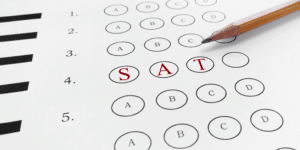Steer clear of rushing, relying on shortcuts, and stressing out, and with practice and patience, you’ll be ready for the big day.
***
You’ll hear it on law school forums, from your pre-law advisor, and in your LSAT prep class: Studying for the LSAT takes time. Sometimes, a very long time.
It’s not unusual for students to spend 3-4 months preparing for one LSAT administration, only to end up postponing until the next. Why? This is because, objectively speaking, the LSAT is an extremely difficult test. Out of every 10,000 people who take the exam, only three achieve the perfect score of 180 on its 120–180 point scale.
Does that mean they get every question right? Not necessarily. A brief look at the LSAT scoring scales from 2005 until 2015 reveals that a test-taker can miss as many as two — even three — questions and still achieve a perfect score. And yet, only three in 10,000 do so.
Of course, the vast majority of test-takers are not aiming for a perfect score, and they don’t need to. Assuming for a respectable undergraduate GPA, a target score in the high 160s or low 170s would be considered perfectly adequate for even the most prestigious U.S. law schools. What does it take to score a 166? You need to correctly answer 80 out of the 100 questions on the test.
Let’s put this in perspective. On most college exams, answering 80 out of 100 questions correctly would give you a B- or lower. But on the LSAT, getting 80 correct answers results in a score that is highly desirable for most applicants. What’s stunning is not how little, but how much it takes to get these results. After all, 92 percent of those who take the test don’t make it that far.
Many would argue that achieving a high score on the LSAT is difficult because the test is deliberately “speeded” you aren’t penalized for guessing, and still most test-takers are unable to complete some of the sections in the 35 minutes allowed for each one. Running out of time, however, is almost always a marker of inefficiency, not inadequate speed.
In Logic Games, for instance, it’s usually a result of missing inferences, improper rule representation, or failure to recognize a “Limited Solution Set Game.” In Reading Comprehension, pacing issues are often caused by an inability to actively engage with the text. Passive reading is not equal to taking your time; in fact, many students are able to gain time by initially slowing down and carefully focusing on the key elements of each passage — structure, tone, main point, purpose, and so on. Which brings us to our first warning:
1. Do not rush!
It is imperative to take your time with the test, especially in the beginning stages of your preparation. Only by developing a solid conceptual understanding of the material will you see improvement in your score — and your pace will eventually pick up, too.
Performing well on LSAT requires solid conceptual understanding of the material being tested: Logic Games, Logical Reasoning, and Reading Comprehension.
Relying on quick fixes and shortcuts (look up “keyword matching,” for instance), may help in some instances; however, these are not bullet-proof methods that can be applied universally and work every time. This is largely due to the complexity of the exam itself, which does not lend itself easily to quick tips or easy shortcuts.
More importantly, shortcuts can be circumvented, and test-makers often do just that. Of course, they have access to the same test-prep materials as you do. If there is a shortcut they can trick you into using blindly, chances are the shortcut won’t get you very far. Which brings us to our second warning:
2. Beware of shortcuts!
It is arguably easier to follow a quick sound bite than an elaborate test of logical validity. And sometimes, shortcuts do work. But quite often they don’t, leading you down the wrong path.
One of the main reasons students tend to look for shortcuts is because they lack confidence that they can do well. Developing a proper LSAT test mentality is therefore key. Contrary to what the LSAC claims, the test does not simply measure the skills you need to succeed in law school; it also measures your psychological response to stress. In limited amounts, stress can be a good thing by sharpening your focus. Panicking, however, can be the kiss of death on the exam.
Since studying for the LSAT can be a mentally exhausting endeavor, you need to learn how to relax and take a break once in awhile. Studies consistently show that if you learn to do that, you’ll be more productive in the long run. Yes, breaks from the LSAT can actually increase your score. Which brings us to our third and final warning:
3. Don’t stress out!
Reducing stress is tricky, of course, because stress is a physiological response to the presence of a stressor over which we have little control. There is no single relaxation technique that suits everyone.
Test anxiety can be managed, however, and the first step to stress management is to build your confidence that you can actually beat the LSAT: The better prepared you are, the less nervous you will be on the day of the test. What’s more, how you expect to perform on the day of the test is often precisely how you end up performing. Because your beliefs inform and influence your actions, they tend to be self-fulfilling prophecies. Expect to do well, and you are more likely to do so.
Of the many techniques for reducing anxiety, three deserve special mention: visualization, breathing techniques, and mindful meditation.
Visualization
Visualization is a technique often used in competitive sports. Prior to a competition, the athlete mentally rehearses what a successful performance will look like. For example, a long jumper would visualize running down the track, seeing every element of a perfect jump all the way through the landing. Research has found that physical and psychological reaction times are improved in situations where athletes visualized perfect performances prior to the actual event. While the LSAT is much more a mental event than a physical one, the technique works equally well. Just before the test, mentally walk through the steps you would take to destroy each section, and see yourself successfully completing all of the questions with time remaining.
Breathing Techniques
One of the main reasons why test anxiety is so detrimental to your score is that when we panic, we lose focus. The words on the page suddenly blur, and all you can think about is how you are not thinking about what you should be thinking about. It’s a vicious circle, I know. Sometimes, the best solutions are the simplest; sit comfortably with your back straight, close your eyes, and focus on breathing — in through your nose, out through your mouth. Do this for 20-30 seconds, and you might well avert a disaster.
Mindfulness
Mindfulness, or mindful meditation, has gained a lot of traction lately. While it has roots in Buddhist teachings, mindfulness training is not spiritually based. Basically, all you need to do is learn how to sit alone in a quiet room, with your eyes closed, for 10-15 minutes at a time, focusing on nothing other than your breathing and your feelings at that moment.
In a study conducted by the University of California at Santa Barbara, students who engaged in mindfulness training for two weeks increased their average GRE verbal scores from 460 to 520, whereas the control group experienced no such benefit. The study also showed that mindfulness can improve your “working memory” — that is, your ability to keep in mind multiple pieces of transitory information. Reading Comprehension anyone? You can use some working memory there.
Steer clear of rushing, relying on shortcuts, and stressing out, and with practice and patience, you’ll be ready for the big day.




